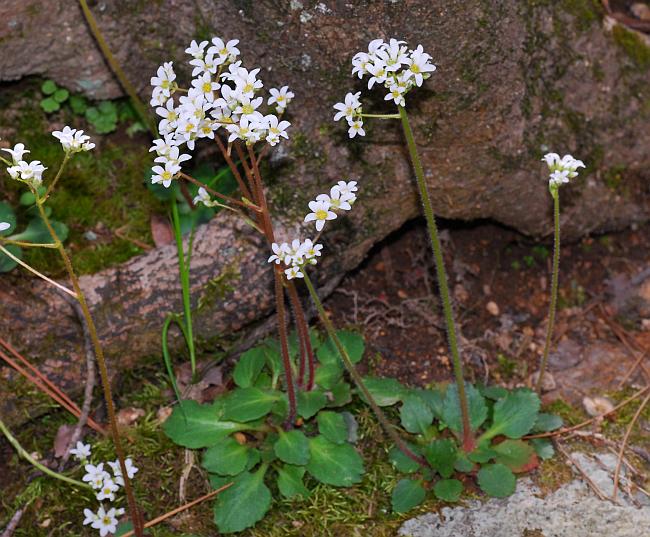Micranthes virginiensis (Michx.) Small
Early Saxifrage

Native
CC = 7
CW = 3
MOC = 14
© SRTurner
Micranthes virginiensis (Michx.) SmallEarly Saxifrage | |
 |
Native CC = 7 CW = 3 MOC = 14 |
© SRTurner |
|
Family - Saxifragaceae Habit - Perennial forb, with fibrous roots and sometimes rhizomes. Stem - Aerial stem absent. Leaves - All basal. Blades 1-5 cm long, tapered or narrowed to a petiole 5-25 mm long, the surfaces glabrous or sparsely to moderately pubescent with usually crinkly multicellular hairs, the margins finely to relatively coarsely scalloped or toothed.
Inflorescence - Panicles 3-30 cm long, condensed at the start of flowering but eventually becoming more open and lax. Main axis moderately pubescent with somewhat spreading, crinkly, multicellular, gland-tipped hairs, these minute or up to about 1 mm long, becoming densely hairy toward the branch tips, sometimes with a few highly reduced leaflike bracts.
Flowers - Actinomorphic. Hypanthium saucer-shaped, fused for less than half the length of the ovary. Sepals 1.2-2.0 mm long at flowering, remaining ascending after the flower opens, ovate to triangular-ovate or oblong-ovate, mostly bluntly to sharply pointed at the tip. Petals glabrous, entire, 3.5-6.0 mm long, narrowly oblanceolate to spatulate or obovate, white. Stamens 10, usually exserted from the calyx, the anthers small. Pistils with usually 2 carpels, mostly broadly ovoid. Ovary 2-locular, the placentation axial. Styles tapered, persistent and arched to spreading at fruiting.
Fruits - Capsules 3-4 mm long (including the stylar beaks). Flowering - February - June. Habitat - Glades, ledges, bluffs, rock outcrops, usually on acidic substrate. Origin - Native to the U.S. Lookalikes - Draba cuneifolia. Other info. - This small species is showy for its size, bearing clusters of small but bright white flowers. It is not particularly common in Missouri, found mostly in a few counties in the Ozarks. It has a distinct preference for rocky, acid soils. Missouri is at the western edge of the plant's normal range, which extends up the Appalachians, through New England, and into Canada. Photographs taken at Silver Mines Recreation Area, Madison County, MO, 03-19-2012, 04-03-2016, 04-13-2017, and 4-14-2025, and at Pickle Springs Natural Area, Ste. Genevieve County, MO, 04-14-2010 and 04-26-2014 (SRTurner). |